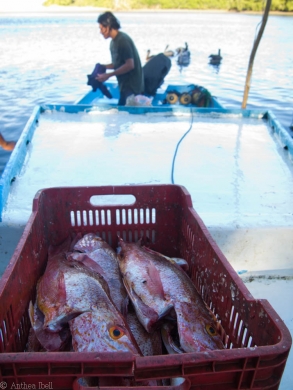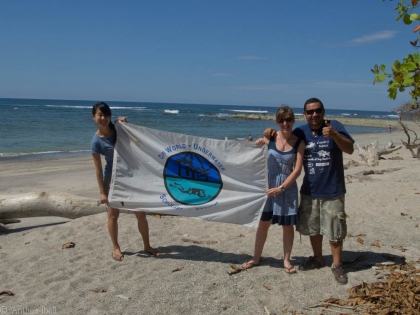In the small Puerto Coyote, on the Nicoya Peninsular of Costa Rica, fishermen head out past the breakers each evening. They lay their line which is held by buoys at either end and consists of many hooks that hang down to the sea floor. For the following 5 or so hours they check the line, pull them in during the early hours of the morning, and make their way back to the port to sell their catch to the local buyer. Workers from Pretoma meet the fishermen around 5am and measure the lengths, weights and gonads of as many catches as they can before the summer sun forces the fishermen to put their fish on ice and send them on their way. The data collected is used to assess the stock of the main fishery of the area- the Red Snapper, Lutjanus guttatus. From this information, Pretoma can make management plans for the fishermen and Government control. With many sanctuaries in the area this stock assessment is useful in assessing the success of these semi-protected, limited fishing, areas.
Many mornings the fishermen return from their nights on the water with hardly enough fish to cover the costs of running the expeditions. The cost of hooks, lights, gas, bait and line all adds up to a reasonable amount. During my volunteer work with Pretoma we entered data from the sales log from the port. It was incredible to see how often the men lose money. They go out every night praying for a big catch.
The main buyer for the area provides ice and transport to Jicaral, the main centre for the region. The fish are bought at a low cost in the port and sold on in Jicaral to be taken throughout Costa Rica and exported to the United States. With each transaction the price increases and the fishermen are left with the lion’s share of the takings. Pretoma is working to cut out the middle men and get better prices for the fishermen by putting in place certifications that show that the fish are caught locally and from a sustainable stock.
During my visit to San Francisco de Coyote I was able to join Erick Lopez, of Pretoma Fisheries and his assistant Sharon Hsu to the Southern beaches of the Nicoya Peninsular. Here we interviewed restaurant/hotel owners and chefs to discuss where they buy their fish and if they would be interested in supporting a local market for the Red Snapper. Many of those questioned said that if they were provided a good price and a sustainable certification for the local fish, they would be interested in working further with Pretoma. This is a step in the right direction for sustainable fishing in Costa Rica. Currently many of the protected and semi protected areas are not enforced due to the lack of resources. If the fishermen are able to get a better price for their catch they will be less likely to take desperate measures such as illegally buying bait caught in protected areas. The UN recently recognised Pretoma’s work and they have been awarded a grant to continue their work with sustainable fishing in Costa Rica.
Many thanks to Randall Arauz for his support and Erick Lopez for all his generosity, support and entertainment. Thanks to Sharon Hsu for her help and translations. I found my time with Pretoma very interesting as they are proving to be a very successful non-profit; slowly but surely the beautiful waters of Costa Rica will be better managed.










